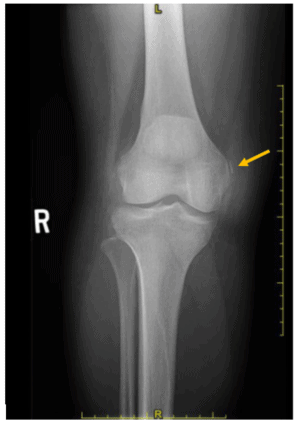Published on
Differential Diagnosis
- Acute Stieda fracture
- Femoral fracture
- Reactive arthritis
- Tendinous calcification

Diagnosis
This patient was diagnosed with an acute Stieda fracture with Stieda-Pellegrini lesions. Stieda fracture is an acute chip avulsion fracture rising from the medial femoral condyle at the site of medial tibiofemoral collateral ligament insertion. The lesion most commonly affects adult patients and is associated with injury.
Learnings/What to Look for
- Clinical findings are painful swelling of the medial knee and diminished range of motion
- Radiographic findings include a chip fracture arising from the upper medial cortex of the medial femoral condyle at the level of medial tibiofemoral collateral ligament insertion and adjoining soft tissue swelling
- MRI findings may include localized tear of medial collateral ligament insertion on the medial femoral condyle, hemorrhage, soft tissue edema, cortical fracture, and/or adjoining marrow edema
Pearls for Urgent Care Management and Consideration for Transfer
- Initial treatment is conservative including immobilization and anti-inflammatory and analgesic medications
- Subsequent management includes physical therapy
- Cases with persistent symptoms, weakness, and dysfunction of medial collateral ligament may require surgical intervention for repair of the ligament
- Untreated cases may have chronic pain and dysfunction of the medial collateral ligament. Untreated cases also may reveal a Pellegrini-Stieda calcification on the medial surface of the upper medial femoral condyle
Acknowledgement: Images and case provided by Teleradiology Specialists, www.teleradiologyspecialists.com.
A 53-Year-Old Female with Painful, Swollen Medial Knee a Fall
1 2
